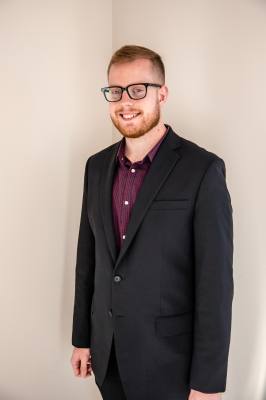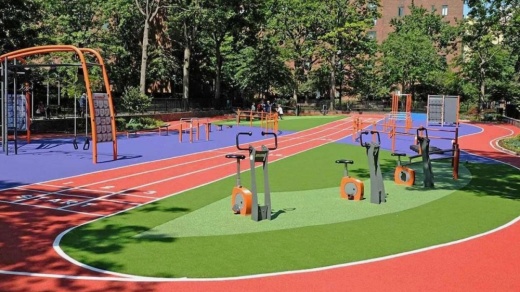The group ride was part of the council member’s Roll with the Council series, an event Woodard started four years ago for people to enjoy informal company and tour the Frisco park and trail system.
The PGA ride was more heavily attended than usual, he said. The hike-and-bike trail ride near the golf courses served as a snapshot of Frisco’s plans to meld the park system with the many construction projects underway in this area, according to Woodard.
“The way parks have been utilized has changed substantially over the last couple of decades. People tend to be more active now, and we’ve seen that especially showing in the last 18 or 24 months with the pandemic,” Woodard said. “That’s really kind of one of the big areas where the park system comes into play.”
What people want
Play Frisco, the city’s parks and recreation department, celebrated 25 years of service this year. Part of that service, Director Shannon Coates said, is to get adults and kids alike out to play.
A strategy to encourage that, she said, is renovating existing facilities across the city. The parks and recreation department does not focus on individual areas, according to Coates, but aims to evenly distribute work across Frisco.
New fixtures being installed at the Cannaday Recreation Area near Clark Middle School on the city’s east side are intended to encourage residents to test themselves, Coates said. The 4-acre park is being redesigned as an athletic training hub. A budget of $500,000 will bring an obstacle course not unlike something from the “American Ninja Warrior” TV show to the neighborhood.
Construction is expected to begin this fall and last about 8-10 months, according to the city.
“We really make an effort into reinvesting, just as we do when we’re building, to really engage the community to see how we can fit their needs,” Coates said. “You’ll see a very strong natural component in all of those parks because that’s really what the community is saying [is], ‘Well, that’s what we want in that area right now.’”
Woodard said the City Council recognizes shifting needs for park fixtures, and that the city needs to offer amenities completely different from the standard open space and ball fields layouts from 20 years ago.
"Those traditional parks are obviously necessary,” Woodard said. “But I think these newer types of parks where we have different kinds of amenities are just as important and provide activities the citizens want as well.”
Another priority both Woodard and Coates underscored is a renewed focus on trail connectivity.
New trail links made under this effort include the creation of the $3 million Dominion Hike and Bike Trail. A trail connection will be developed along the Panther Creek tributary between Hillcrest Road and Preston Road, according to a July parks report. Bidding for this project is planned for late 2021.
This 1.2-mile trail will connect existing trail sections located within the Dominion at Panther Creek subdivision and an existing section of trail located north of the Latera subdivision near Preston Road. A bridge connection from the Creekside at Preston subdivision to the Dominion at Panther Creek subdivision will allow users to access the Coyote Crossing neighborhood park.
Coates said the city is aiming to offer ease of access to parks across the city, even across areas of Frisco yet to be developed.
“If you were to look at a map of Frisco and see what’s not quite developed yet, you’ll see these small gaps where we can’t quite get people across the city. But we’re really close,” Coates said. “We’re just getting better and better, and more and more is getting connected.”
Planning ahead
Mike Barber, the Frisco Community Development Corp. president, said the CDC works with Play Frisco and other city officials in anticipating future needs for park space.
The CDC is the primary funding source for the parks and recreation department, drawing funds from a half-cent of the city’s sales tax revenue. Barber said parkland is vital to Frisco development moving forward.
“We believe it’s a very important aspect of the city to have not only these park areas, but trails for people to be able to walk from place to place,” Barber said. “Hopefully that continues to evolve as the city grows.”
Included in those vital plans are visions for Grand Park, the 275-acre regional park heralded by the city as its version of New York’s Central Park. The expansive project will be located along Dallas North Tollway, east of Legacy Parkway and north of Stonebrook Parkway.
“Grand Park, obviously, is a huge piece of land that has a lot of different potential to it,” Barber said. “I think it’s more about deciding how we’re going to use the designated park areas we currently have versus looking to add on.”
Woodard said planning for Grand Park is a top priority for the city moving forward.
City officials have said the main obstacle in advancing plans for Grand Park has been cleaning up contamination from the former Exide Technologies battery recycling plant. After the 87th meeting of the Texas Legislature, the city has access to more state funds to help complete that cleanup.
Woodard said that Grand Park will be consequential thanks to its size and the atypical approach the city is taking in planning for it. For instance, council members are considering water elements, performance stages and festival areas.
“One, because of its size, and two, because it’s so central to the city and it’s going to be more of a ‘passive’ park in that it’s not going to have a ball field to it—it’s going to have a lot of different types of amenities to it,” he said. “I think that’s going to be a real asset for the community.”
Key benefits
National nonprofit The Trust for Public Land advocates for the creation and protection of parks to promote health and livability.
Molly Plummer, senior program manager for the nonprofit’s North Texas region, said preserving parkland in the midst of heavy home construction and the COVID-19 pandemic is vital.
She said right now is the best time for city officials to conserve parkland for greenspace before parts of Collin County develop without it. Thousands of people, Plummer said, are moving into Collin County due to an increased demand for homes in urban areas.
Plummer added that park funding is at risk across the country due to economic consequences of COVID-19.
“Development and construction has now picked back up in the region and is moving full steam ahead,” Plummer said. “We still need to prioritize protecting and creating parks that serve those new communities and the existing ones in North Texas as development continues.”
Coates said the city remains focused on the park system despite high demand for land from homebuilders. Fees are imposed on home developers in Frisco whenever they build out new communities, and with that money, the parks director said the city can only invest toward a park in that nearby community.
“We actually have ordinances in place that are protecting parkland when a developer comes in and wants to build. ... There are requirements for them based on our ordinance and our formula of how much they’re required to give,” Coates said. “I think that our leaders who have been in place for a long time were able to look ahead very well into the future.”
Walkability to parks within the city is a main focus for both The Trust for Public Land and the city of Frisco.
Coates said a majority of residences within the city have access to parks within a 10-minute walk.
Communities and individuals see health benefits from having a park, trail or greenspace within a 10-minute walk of their home, according to Plummer. She said a key reason this is important in Texas is that they help to combat heat during summer months.
“Close-to-home parks are critical to community health and resiliency—we really saw how important these shared outdoor spaces were during the initial COVID[-19] lockdown,” Plummer said. “Parks provide a multitude of environmental, economic, community and health benefits to those who live near them.”





